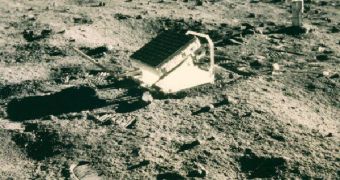Astronauts that flew to the Moon via the Apollo program left behind a host of scientific experiments on the lunar surface, including a few sets of mirrors. These instruments were designed in such a manner that a laser beam shone from Earth would be reflected back. This enabled physicists to conduct various types of scientific studies, but it would appear that now lunar dust is preventing them from assessing whether Einstein's theory on general relativity is accurate or not. The issue now is that that mirrors are losing their ability to reflect back laser light precisely, which hinders accurate measurements.
Laser experiments in which light was directed at the Moon mirrors provided us thus far with the most extensive knowledge on Einstein's theory. Experts shine beams of laser several times each month on the network of mirrors left behind by the Apollo 11, 14 and 15 missions, as well as by the two Soviet landers Lunokhod. By analyzing how fast the light returns, they can measure the exact distance the Moon is from Earth, with incredible accuracy. Physicists say that the margin for error in these estimates used to be 1 millimeter, a level sufficiently detailed to allow for experts to find potential cracks in the theory of relativity, NewScientist reports.
But now the reflective capabilities of the mirrors have decreased considerably. “The lunar reflectors are not as good as they used to be by a factor of 10,” says University of California in San Diego (UCSD) astronomer Tom Murphy. He is the leader of one of the science teams working at the Apache Point Observatory in analyzing the laser signals returning from the Moon. The expert says that analysis of the observations records showed that the problem first appeared between 1979 and 1984, and that the situation has deteriorated since. He adds that the Apache experiment has a sufficiently powerful laser to continue measurements for some time, but says that other lasers may not be strong enough to get a reflection.
When a beam of photons is fired at the Moon, some of them are absorbed by the Earth's atmosphere on their way out, some miss the mirrors altogether, and only a small portion gets reflected back. An even smaller number manages to pass through the atmosphere again, and make their way to the detectors back on our planet. Dust on the Moon further reduces the number of photons that get sent back, and the experts believe that the surface of the mirrors may either be covered in the stuff, or may have suffered scratches. The study, submitted for publication in the scientific journal Icarus, highlights the potential problems that astronomers seeking to build a telescope on the Moon may face in the future.

 14 DAY TRIAL //
14 DAY TRIAL //